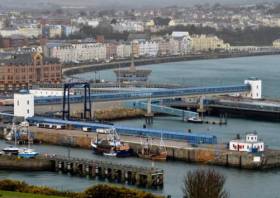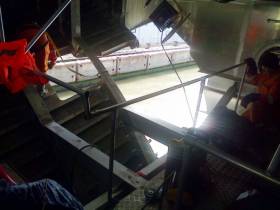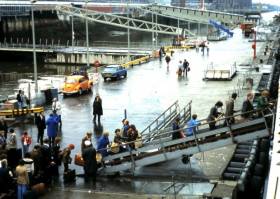Displaying items by tag: IOM Steam Packet
#FerryNews - The main Isle of Man Steam Packet Company ferry, Ben-my-Chree departed Douglas for Merseyside where yesterday the ropax entered dry-dock in Birkenhead for its regulatory overhaul.
According to the operator, the ferry will undergo a scheduled three-week dry-docking which Afloat adds is taking place at marine engineering firm Cammell Laird.
During the overhaul the chartered in freight-only MV Arrow will provide freight services.
As for ferry passenger services, fast craft Manannan will operate according to the schedule published last autumn.
Until May 8, sailings are scheduled to depart Douglas for Heysham at 08.00 and for Liverpool at 15.30, with the return sailings departing Heysham at 12.00 and Liverpool at 19.30. The only exceptions will be today (April 18) and April 25 when Manannan will operate the Belfast route instead of Heysham.
A coach service will be provided at Heysham to transfer foot passengers to and from Lancaster railway station.
Chief Executive Mark Woodward said: ‘It is a regulatory requirement that Ben-my-Chree undergoes a technical overhaul.
‘This does mean the vessel is unavailable for three weeks, requiring some changes to our sailings during this period. We published Manannan’s revised schedule last autumn to give as much notice as possible and will assist foot passengers travelling onwards, via Heysham, by providing a coach to and from Lancaster station.
‘Freight services will be provided by MV Arrow, once again underlining the value to the Island of the significant investment we are making to retain the vessel.
‘Ben-my-Chree will be back soon, fully serviced and ready for another busy summer season.’
Port Revamp On Isle of Man Not Linked to Ferry Shake-Up
#FerryNews- An £80m planned redevelopment of Douglas Harbour, Isle of Man has nothing to do with a possible shake-up of ferry services, the Chief Minister has insisted.
Construction of an £11m cruise berth reports IOM Today, on the outer side of an extended Victoria Pier is the centrepiece of a three-year programme of works for the harbour area.
Others works include £14.83m upgrades to the Kind Edward VIII Pier, windfarm support vessel pontoons, new breakwater and revetment costing £17.22m and a pleasure craft slip and holding area costing £6.98m.
The final year will see an upgrade to the tanker berth costing £15.55m, and upgrade to the Victoria Pier ro-ro berth costing £10.56m and a cruise tender berth costing £4.23m.
A harbour strategy, approved by Tynwald this week, appears to indicate the government is laying the groundwork for a shake-up of ferry services.
For more on the redevelopment click here.
Isle of Man Steam Packet's Ropax Reliability Record of More than 99%
#Ferry - Ben-My-Chree, the ropax Isle of Man Steam Packet Company ferry completed 2017 with a reliability record of more than 99%.
Operating services throughout the year, Ben-My-Chree chiefly serves Douglas-Heysham crossings and weekend sailings to Birkenhead during the winter months. In addition the ropax operates seasonal services to Belfast and Dublin throughout the summer months.
During the 2017 season Ben-my-Chree:
- Operated 1,375 sailings, travelling more than 83,000 miles
- Had a 99.49% technical reliability record, with only seven trips cancelled during 2017
- Operated at 97.01% overall reliability, once weather cancellations are taken in to account
- Main engines accumulated 10,685 running hours
Steam Packet Company Chief Executive Mark Woodward said: ‘Once again Ben-my-Chree has served the Island well and had a great reliability record during 2017, with very few cancellations due to technical issues. Disruptions were mainly caused by weather including storms Aileen, Brian and Caroline during the latter part of the year.’
Ben-my-Chree is scheduled to go to dry dock for her planned biennial overhaul this year between 17th April and 8th May. The overhaul costing £1.6m will be spent in various areas both above and below deck.
While Ben-my-Chree undergoes the overhaul, Manannan will operate the morning sailings to Heysham, Cumbria departing at 0800hrs and returning from Heysham at 1200hrs.
Changes to Northern Ireland-Isle of Man Ferry Dropped
#ferrynews - Plans to overhaul ferry services between Northern Ireland and the Isle of Man have been dropped writes BBC News after a three-week public consultation.
The Steam Packet Company had considered re-routing sailings (as previously reported on Afloat) to the port of Larne instead of Belfast Dock.
A spokesman said Larne could better accommodate heavier vehicles such as vans, motor homes and coaches.
Despite this, the consultation showed that passengers preferred the "convenience" of sailing to Belfast.
While the route will remain unchanged for the duration of 2018, the Steam Packet company said discussions will continue to improve facilities at Belfast.
"If those upgrades cannot be undertaken it will make sense for the Isle of Man if we look again at Larne to provide a service for larger vehicles", said company chief Mark Woodward.
#ArrowAway - Afloat has tracked down relief freight ro-ro Arrow which had been wintering in the Port of Larne but is currently operating UK-Dutch routes having been sub-chartered by the Isle of Man Steam Packet, writes Jehan Ashmore.
Arrow is owned by Seatruck Ferries but since 2014 has been on long-term charter to the Manx operator. This arrangement is to provide back-up support to ropax Ben-My-Chree when required. As for fast-ferry Manannan see related Larne coverage.
Stena Line have chartered the Arrow for services on the North Sea during dry-docking period of one of their largest UK serving ships. The giant 63,600 tonnes cruiseferry Stena Hollandica normally operates Harwich-Hoek van Holland route but is receiving work in Rotterdam's Schiedam district.
The southern North Sea route is also served by sister, Stena Britannica which can accommodate 1,200 passengers.
In comparison to the Stena Hollandica which can take 300 trucks, Stena announced the charter of a ‘small’ replacement vessel, in which Afloat can confirm is Arrow with its 84 truck capacity. Asides Harwich-Hook van Holland, Stena operates the following freight only North Sea routes of Killingholme-Hoek van Holland and Killingholme-Rotterdam (Europoort).
Stena added that on certain sailings (by Arrow) this may cause some constraints in terms of lane-meters and drivers capacity. As previously covered on Afloat, Stena last Autumn provided additional freight capacity, giving Irish hauliers more options on the ‘Landbridge’ routes to the Netherlands. This saw the Caroline Russ chartered to the operator and join Stena Scotia, a former Irish Sea freight-ferry.
Stena Scotia was introduced on the route the previous Autumn of 2014 as a complement to a pair of much larger ro-ro freighters, Stena Transit and Stena Transporter on the Hoek van Holland – Killingholme route.
Killingholme, Lincolnshire is a port located on the Humber estuary, further north of Harwich. Likewise of the Essex port this is a busy North Sea freight hub. On the opposite side of the estuary is Hull, again another major port but with passengers / freight services operated by P&O Ferries serving the Netherlands and Belgium.
#LiverpoolBerth - Before plans for a new landing berth in Liverpool for the Isle of Man ferries can go ahead, several questions must be answeered says TravelWatch.
The IOM Today writes that the passenger watchdog held a public meeting last Thursday when numerous issues were raised.
Infrastructure Minister Phil Gawne MHK has visited Liverpool to meet the city’s Mayor Joe Anderson to discuss plans to relocate the Steam Packet berth from its historic Pier Head location to make way for a cruise liner terminal. A new site to the north at Waterloo Dock has been earmarked for Manx ferries.
The proposed new landing stage will be almost half a mile away from the current one.
The cost of the move has been estimated at £15m, but Mr Gawne has described that figure as ‘ridiculously optimistic’.
For further coverage on plans for the ferry terminal relocation, click here.
Damaged Fastferry Remains Out of Action Until Sunday
#RepairDelays - The damaged Isle of Man Steam Packet fastferry Manannan has not returned to service as planned this morning - and will remain out of action until Sunday at the earliest.
According to IOM Today, the fastferry is to remain in dry dock at Cammel Laird’s shipyard in Birkenhead undergoing repairs after crashing into Victoria Pier in Douglas a week ago.
A statement from the company isued this morning said: ‘The Steam Packet Company regrets that Manannan will not be able to return to service today as planned.
‘Unfortunately we have been unable to finish the work within the compressed timetable after getting into dock 24 hours later than expected due to the previous ship in there over-running.
‘Due to low tide heights over the next few days the first available un-docking tide is 7am on Sunday, April 3.
‘The Steam Packet Company would like to apologise for the ongoing inconvenience to passengers , we are working on alternative sailing arrangements and will issue an update later this morning. We would ask that passengers do not call until the alternative arrangements are announced later.’
For the latest information on ferry sailings and services, visit the operators website here.
Liverpool Visit by Minister for Talks Over Landing Stage Funding
#NewBerth - Isle of Man ferry services will require significant investment from the Manx government for a new Liverpool landing stage.
According to IOM Today, Infrastructure Minister Phil Gawne and senior officers will be meeting Liverpool Mayor Joe Anderson in the city this week to discuss a scheme, previously estimated at £15m to relocate the berth from its historic Pier Head site at Prince’s Dock.
The new location will be just to the north at Waterloo Dock to which a new access road will be constructed. Work could start in 2017.
For further details on plans for the new berthing development, click here.
Ferry Special Service to Isle of Man TT 2015 Races
#FerryTT2015- A special ferry service between Larne-Douglas begins tomorrow (3 June) as the Isle of Man hosts the annual prestigious TT Races which are already underway, writes Jehan Ashmore.
The Isle of Man Steam Packet will operate a fast-ferry service to the island where the TT2015 motorcycle races are set on a 37 mile-plus Mountain Course circuit.
Fast-craft Manannan, will run the 2 hour 45 minute service until 15 June, three days after the TT race programme ends.
During TT2015 the Manannan will also operate on selected dates on the Belfast-Douglas route in addition to those sailings serving the Dublin-Douglas link.
For information and sailings schedule visit the Steam-Packet website here.
Fast-Ferry Resumes Isle of Man Service Following Repairs
#FerryResumes - The Isle of Man Steam Packet Company's fast-ferry Manannan resumed scheduled services today on the Douglas-Liverpool route.
The craft completed sea trials ysterday after extensive repairs. As previously reported, the craft was damaged having taken an injestion of floating debris in the water before Easter.
The Steam Packet's Chief Executive Mark Woodward commented yesterday: 'Following repairs to the two starboard water jets and the starboard trim tab Manannan has just completed berthing trials and a short sea trial off Douglas. I am pleased to advise that everything went well and the vessel is ready to return to operational service'.
'I would like to thank our passengers for their patience and understanding while Manannan was being repaired. This has obviously been a difficult period and I want to again apologise for the inconvenience caused to passengers.
'The nature of the damage suffered was the worst we have seen to one of our fast craft vessels. Our team of engineers and divers has worked tirelessly to ensure Manannan was returned to normal service as quickly as possible.'


































































